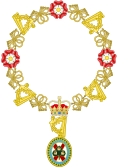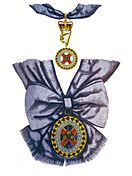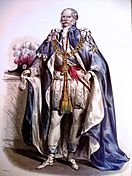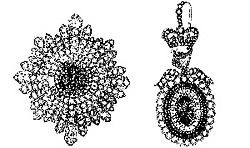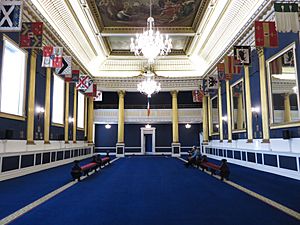Order of St Patrick facts for kids
Quick facts for kids Most Illustrious Order of Saint Patrick |
|
|---|---|
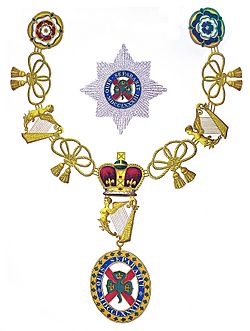
Insignia of a Knight of the Order of St. Patrick
|
|
| Awarded by the monarch of the United Kingdom |
|
| Type | Order of chivalry |
| Established | 1783 |
| Motto | Quis separabit? |
| Criteria | At the monarch's pleasure |
| Status | Last appointment in 1936 Dormant order since 1974 |
| Sovereign | Charles III |
| Grades | Knight (KP) |
| Precedence | |
| Next (higher) | Order of the Thistle |
| Next (lower) | Order of the Bath |
Riband of the Order of St. Patrick |
|
The Most Illustrious Order of Saint Patrick is a special group, or order of chivalry, from Britain that was connected to Ireland. It's called "dormant" because no new members have joined for a long time.
King George III started the Order in 1783. He did this at the request of the person in charge of Ireland at the time, The 3rd Earl Temple. New knights were regularly chosen until 1922. This was when most of Ireland became independent as the Irish Free State.
Even though the Order still officially exists, no new Knight of St Patrick has been chosen since 1936. The last living knight, Prince Henry, Duke of Gloucester, passed away in 1974. Today, Charles III is still the leader, called the Sovereign, of the Order.
The Order's special saint is St Patrick. Its motto is Quis separabit?, which is Latin for "Who will separate [us]?". This phrase comes from a Bible verse.
Most British orders of chivalry are for the whole United Kingdom. But the three most important ones are each for a different country. The Order of St Patrick was for Ireland. It is the newest and lowest in rank of these three. The one for England is the Most Noble Order of the Garter. It is the oldest order in the British Isles, started in the 1300s. The one for Scotland is the Most Ancient and Most Noble Order of the Thistle, which started in its current form in 1687.
Contents
History of the Order
How the Order Started
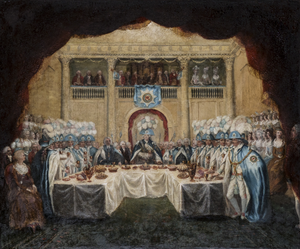
The Order began in 1783. This was a year after Ireland gained more self-rule. It was a way to reward people or gain political support in the Irish Parliament. The Order of the Bath, started in 1725, had similar reasons.
The rules for the Order said that only men who were both knights and "gentlemen" could join. A gentleman meant someone whose family had a coat of arms for three generations on both their father's and mother's sides. But in reality, only Irish nobles and British princes ever became members.
The cross of St Patrick was chosen as one of the Order's symbols. This cross is red on a white background. A flag with this design was later added to the Union Flag (the UK flag). It's not clear if this cross was linked to St Patrick or Ireland before the Order began. One of the first knights was the 2nd Duke of Leinster. His family's coat of arms already had this same cross.
After 1922: A Dormant Order
The last non-royal person to join the Order was the 3rd Duke of Abercorn in 1922. He was the first leader of Northern Ireland. When the Irish Free State left the United Kingdom in December 1922, its government decided not to appoint any more members to the Order.
Since then, only three people have been appointed. All of them were members of the British Royal Family. The future King Edward VIII joined in 1927. His younger brothers, Prince Henry, Duke of Gloucester, joined in 1934, and Prince Albert, Duke of York (who later became King George VI) joined in 1936.
The Constitution of Ireland from 1937 says that the country cannot give out "titles of nobility." It also says that citizens cannot accept such titles without the government's permission. Experts disagree if this rule stops Irish citizens from joining the Order of St Patrick. Some think "titles of nobility" means only inherited noble titles, not lifetime honors like knighthoods. But the rule also mentions "titles of honour."
The last non-royal person to receive the Order, the 9th Earl of Shaftesbury, died in 1961. Prince Henry, Duke of Gloucester, was the last living knight when he died in 1974. The Order still officially exists with the Sovereign (the King) and one officer, the Norroy and Ulster King of Arms.
Could the Order Be Revived?
In 1943, Prime Minister Winston Churchill thought about bringing the Order back. He wanted to honor General Sir Harold Alexander for his service in North Africa. General Alexander's family was from County Tyrone in Northern Ireland. But other government officials thought it might cause problems between London and Dublin.
Later, in the 1960s, Taoiseach Seán Lemass (the Irish Prime Minister) also thought about reviving the Order. However, he did not make a final decision.
Members and Officers
Who Were the Members?
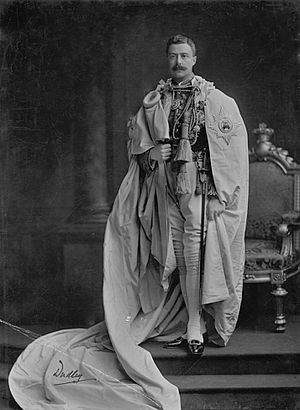
The British monarch is the Sovereign (leader) of the Order of St Patrick. The Lord Lieutenant of Ireland was the Grand Master. This person was the monarch's representative in Ireland. The job of Lord Lieutenant ended in 1922. The last Grand Master was The 1st Viscount FitzAlan of Derwent.
At first, the rules didn't say that the Grand Master had to be a member of the Order. Some Lords Lieutenant were members, but it wasn't always the case. In 1839, Queen Victoria changed this. Grand Masters were allowed to keep their special items even after their term ended.
The Order originally had fifteen knights, plus the Sovereign. In 1821, George IV added six more knights. He officially changed the rules in 1833, increasing the limit to twenty-two knights.
The Order of St Patrick was different from the English and Scottish orders. It only ever appointed nobles (peers) and princes. Women were never allowed to join the Order of St Patrick. They could not join the other two orders until 1987. The only woman involved was Queen Victoria, as she was the Sovereign. Even though the Order was linked to the Church of Ireland until 1871, several Catholics became members over time.
The Order's Officers
The Order of St Patrick started with thirteen officers. These included the Prelate, Chancellor, Registrar, Usher, Secretary, Genealogist, King of Arms, two heralds, and four pursuivants. Many of these jobs were held by religious leaders from the Church of Ireland. After the Church of Ireland was no longer the official state church in 1871, these religious leaders stayed in their roles until they died. Then, the jobs were either ended or given to non-religious officials. Today, only the Registrar and King of Arms positions are still filled.
The Prelate was the Lord Archbishop of Armagh. This was the most senior religious leader in the Church of Ireland. This job was added shortly after the Order began. Since the last Prelate died in 1885, the job has been empty.
The Lord Archbishop of Dublin was originally the Chancellor of the Order. After 1886, the Chief Secretary for Ireland held this job. Since the Chief Secretary position was ended in 1922, the Chancellor job has been empty.
The Dean of St Patrick's Cathedral was the Registrar of the Order. In 1890, this job was combined with the King of Arms of the Order. This position was held by the Ulster King of Arms, Ireland's main heraldic official. In 1943, this job was split due to the partition of Ireland. The part related to Northern Ireland was combined with the Norroy King of Arms. The job of Norroy and Ulster King of Arms still exists. This person still holds the jobs of Registrar and King of Arms for the Order of St Patrick. The part of the Ulster King of Arms job related to the Irish Free State (now Ireland) became the Chief Herald of Ireland.
The Order also had six other heraldic officers. These included two heralds, called Cork and Dublin Heralds. There were also four pursuivants, one of whom was called Athlone Pursuivant.
The Usher of the Order was called "the Usher at Arms named the Black Rod." This person was different from the English officer with the same name.
The jobs of Secretary and Genealogist were originally held by members of the Irish House of Commons. The Secretary job has been empty since 1926. The Genealogist job was empty in 1885, brought back in 1889, but then left empty again in 1930.
Special Clothing and Jewels
For important events like coronations, Knights of St Patrick wore fancy clothes:
- The mantle was a sky-blue robe with white silk lining. The Order's star was on the left side. A blue hood was attached.
- The hat was first white satin, then changed to black velvet by George IV. It had three feathers: red, white, and blue.
- The collar was gold. It had Tudor roses and harps linked by knots. The badge of the Order hung from the central harp.
For less formal occasions, simpler items were used:
- The star was an eight-pointed shape with rays. In the middle was the motto, the year the Order started, and the same design as the badge. It was pinned to the left chest.
- The broad riband was a sky-blue sash worn from the right shoulder to the left hip.
- The badge was pinned to the sash at the left hip. It was gold and showed a shamrock with three crowns. This was on top of a St Patrick's cross. A blue circle around it had the motto and the founding date (1783 in Roman numerals).
The Grand Master's special items looked like the Knights'. But in 1831, William IV gave the Grand Master a star and badge made of rubies, emeralds, and Brazilian diamonds. These were called "Crown Jewels" in the Order's rules from 1905. Newspapers called them the "Irish Crown Jewels" when they were stolen in 1907. The collars of five Knights were also stolen. They have never been found.
Some items from the Order of St Patrick are in museums in both the Republic of Ireland and Northern Ireland. The robes of The 4th Baron Clonbrock are in the National Museum of Ireland in Dublin. The robe of The 3rd Earl of Kilmorey is in the Newry Museum. The National Gallery and Genealogical Museum in Dublin have Stars of the Order. The Ulster Museum in Stranmillis has a large collection on display. The Irish Guards use the Order's capstar and motto.
Chapel and Hall
The Order's special chapel was originally in St Patrick's Cathedral in central Dublin. Each member had a special seat in the choir of the Chapel. Above their seat, their family symbols (heraldic devices) were shown. A helmet with a crest was on top of the seat. Above the crest, the knight's special flag (banner) with his coat of arms was hung. A small brass plate was attached to the back of the seat. It showed the knight's name, arms, and when he joined. When a Knight died, his banner and crest were taken down and replaced by his successor's. After the Church of Ireland was no longer the official state church in 1871, the Chapel was no longer used for the Order. But Queen Victoria asked for the knights' symbols to stay in place.
The Order didn't have a ceremonial home until 1881. Then, banners, helmets, and special plates were put in the Great Hall at Dublin Castle. This hall is officially called St. Patrick's Hall. When the Irish Free State was formed, the banners of the living knights were removed. In 1962, the Hall was redecorated. It was decided to hang the banners of the members of the Order from 1922. These banners can still be seen today.
St Patrick's Hall was named after its connection to the Order. It also served as the Order's main office. Ceremonies to welcome new members were held here, often on St Patrick's Day. A special dinner for the Knights was also often held in the Hall. Today, St Patrick's Hall is where the President of Ireland is officially sworn into office.
Special Privileges
Since members of the Order were already knights and usually had high social rank, many of the special benefits of being a member didn't change much for them. As knights, they could put "Sir" before their first names. But they were usually called by their noble titles instead. They were given a special place in the order of importance, but their noble titles already gave them higher positions.
Knights used the letters "KP" after their names. If someone had many titles, "KP" came before most others.
Knights could show their family's coat of arms with a blue circle around it. This circle had the Order's motto. The badge hung from this circle. They could also have special figures, called heraldic supporters, on either side of their coat of arms. This was a very high privilege. Only members of the Royal Family, nobles, and members of the highest orders could usually have supporters. Since Knights of St Patrick were almost always nobles or princes, they usually had the right to supporters anyway.
See also
- List of Knights of St Patrick



